
A ship of the line was a type of naval warship constructed during the Age of Sail from the 17th century to the mid-19th century. The ship of the line was designed for the naval tactic known as the line of battle, which depended on the two columns of opposing warships maneuvering to volley fire with the cannons along their broadsides. In conflicts where opposing ships were both able to fire from their broadsides, the opponent with more cannons firing – and therefore more firepower – typically had an advantage. Since these engagements were almost invariably won by the heaviest ships carrying more of the most powerful guns, the natural progression was to build sailing vessels that were the largest and most powerful of their time.

Galleons were large, multi-decked sailing ships first used as armed cargo carriers by European states from the 16th to 18th centuries during the age of sail and were the principal vessels drafted for use as warships until the Anglo-Dutch Wars of the mid-1600s. Galleons generally carried three or more masts with a lateen fore-and-aft rig on the rear masts, were carvel built with a prominent squared off raised stern, and used square-rigged sail plans on their fore-mast and main-masts.
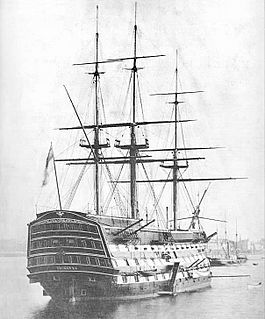
In the rating system of the British Royal Navy used to categorise sailing warships, a first rate was the designation for the largest ships of the line, equivalent to the "super-dreadnought" of more recent times. Originating in the Jacobean era with the designation of Ships Royal capable of carrying at least 400 men, the size and establishment of first-rates evolved over the following 250 years to eventually denote ships of the line carrying at least 80 guns across three gundecks. By the end of the eighteenth century, a first-rate carried no fewer than 100 guns and more than 850 crew, and had a measurement (burthen) tonnage of some 2,000 tons.

Golden Hind was a galleon captained by Francis Drake in his circumnavigation of the world between 1577 and 1580. She was originally known as Pelican, but Drake renamed her mid-voyage in 1578, in honour of his patron, Sir Christopher Hatton, whose crest was a golden hind. Hatton was one of the principal sponsors of Drake's world voyage. A full-sized, seaworthy reconstruction is in London, on the south bank of the Thames.

The Manila galleons were Spanish trading ships which for two and a half centuries linked the Spanish Captaincy General of the Philippines with New Spain across the Pacific Ocean, making one or two round-trip voyages per year between the ports of Acapulco and Manila, which were both part of New Spain. The name of the galleon changed to reflect the city that the ship sailed from. The term Manila galleon can also refer to the trade route itself between Acapulco and Manila, which lasted from 1565 to 1815.
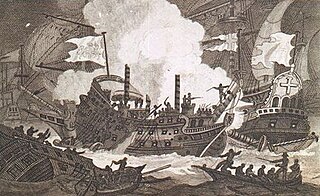
Revenge was an English race-built galleon of 46 guns, built in 1577 and captured by the Spanish in 1591, sinking soon afterwards. She was the first of 13 English and Royal Navy ships to bear the name.
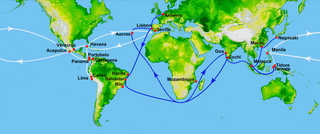
The Spanish treasure fleet, or West Indies Fleet Spanish: Flota de Indias, was a convoy system of sea routes organized by the Spanish Empire from 1566 to 1790, which linked Spain with its territories in the Americas across the Atlantic. The convoys were general purpose cargo fleets used for transporting a wide variety of items, including agricultural goods, lumber, various metal resources such as silver and gold, gems, pearls, spices, sugar, tobacco, silk, and other exotic goods from the overseas territories of the Spanish Empire to the Spanish mainland. Spanish goods such as oil, wine, textiles, books and tools were transported in the opposite direction.
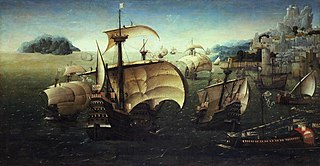
A carrack is a three- or four-masted ocean-going sailing ship that was developed in the 14th to 15th centuries in Europe, most notably in Portugal. Evolved from the single-masted cog, the carrack was first used for European trade from the Mediterranean to the Baltic and quickly found use with the newly found wealth of the trade between Europe and Africa and then the trans-Atlantic trade with the Americas. In their most advanced forms, they were used by the Portuguese for trade between Europe and Asia starting in the late 15th century, before eventually being superseded in the 17th century by the galleon, introduced in the 16th century.
Dreadnought was a 41-gun galleon of the Tudor navy, built by Mathew Baker and launched in 1573. Like HMS Dreadnought of 1906, she was a radical innovation over contemporary ships. When John Hawkins became Treasurer of the Navy in 1577, he had sailed all over the world, and his ideas contributed to the production of a new race-built series of galleons—of which Dreadnought was the second, following Foresight of 1570—without the high forecastle and aftcastle prevalent in earlier galleons. These "marvels of marine design" could reputedly "run circles around the clumsier Spanish competition."

The Spanish Armada was a Habsburg Spanish fleet of 130 ships that sailed from Lisbon in late May 1588 under the command of the Duke of Medina Sidonia, with the purpose of escorting an army from Flanders to invade England. Medina Sidonia was an aristocrat without naval command experience but was made commander by King Philip II. The aim was to overthrow Queen Elizabeth I and her establishment of Protestantism in England, to stop English interference in the Spanish Netherlands, and to stop the harm caused by English and Dutch privateering ships that disrupted Spanish interests in the Americas.

HMS Centurion was a 60-gun fourth rate ship of the line of the Royal Navy, built at Portsmouth Dockyard and launched on 6 January 1732. At the time of Centurion's construction, the 1719 Establishment dictated the dimensions of almost every ship being built. Owing to concerns over the relative sizes of British ships compared to their continental rivals, Centurion was ordered to be built 1 ft (0.3 m) wider across the beam than the Establishment prescribed. HMS Rippon was similarly built to non-Establishment dimensions at the same time.

Triumph of 1562 was the first vessel of record to hold the name. She was a 60-gun English galleon built in Deptford in 1561–62 and launched in October 1562.
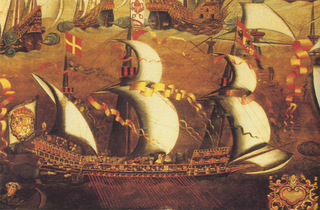
Galleasses were military ships developed from large merchant galleys, and intended to combine galley speed with the sea-worthiness and artillery of a galleon. While perhaps never quite matching up to their full expectations, galleasses nevertheless remained significant elements in the early modern naval armoury for some considerable time.

Warspite was a great ship of the English Tudor navy. The vessel was built at Deptford Dockyard by the master shipwright Edward Stevens and launched about 1 March 1596. She carried a crew of 300 when at sea, of whom 190 were classed as "mariners", manning the guns and fighting the ship; 80 as "sailors", working the sails and ancestors of present-day seamen and 30 "gunners", the armament specialists.

The Battle of Cape Celidonia took place on 14 July 1616 during the Ottoman-Habsburg struggle for the control of the Mediterranean when a small Spanish fleet under the command of Francisco de Rivera y Medina cruising off Cyprus was attacked by an Ottoman fleet that vastly outnumbered it. Despite this, the Spanish ships, mostly galleons, managed to repel the Ottomans, whose fleet consisted mainly of galleys, inflicting heavy losses.

The Battle of Santa Cruz de Tenerife was a military operation in the Anglo-Spanish War (1654–60) which took place on 20 April 1657. An English fleet under Admiral Robert Blake penetrated the heavily defended harbour at Santa Cruz de Tenerife in the Spanish Canary Islands and attacked their treasure fleet. The treasure had already been landed and was safe but the English engaged the harbour forts and the Spanish ships, many of which were scuttled and the remainder burnt. Blake having achieved his aim then withdrew without the loss of a single ship.

The Battle of the Barbary Coast was a minor naval engagement that took place off in the Barbary Coast not far from the Gibraltar Strait, on July 26, 1592 during the Anglo-Spanish War. The hard fought action by an English merchant galleon in the Amity of London captained by Thomas White resulted in the capture of two Spanish ships which included a galleon despite them being outnumbered four to one. The prizes were heavily laden with quicksilver and a large amount of very important Papal bulls bound for the West Indies.
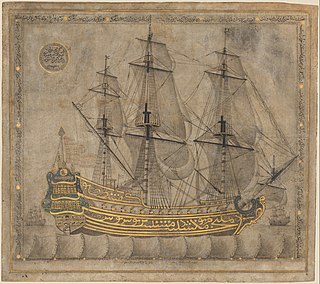
The Calligraphic Galleon is an example of Islamic calligraphy dating to the mid-18th century. Attributed to a calligrapher in the Ottoman Empire, the work depicts a galleon of the Ottoman navy. The ship is inscribed with the names of the Seven Sleepers, a group of men who were protected by the Abrahamic God, likely to confer a blessing of protection on the ship. It is in the collection of the Metropolitan Museum of Art.

The race-built galleon was a type of war ship built in England from 1570 until about 1590.















